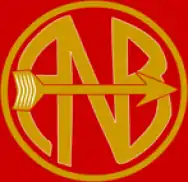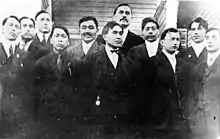Alaska Native Brotherhood/Sisterhood
The Alaska Native Brotherhood (ANB) and its counterpart, the Alaska Native Sisterhood (ANS), are two nonprofit organizations founded to address racism against Alaska Native peoples in Alaska. ANB was formed in 1912 and ANS founded three years later. For the first half of the 20th century, they were the only organizations working for the civil rights of Alaska Natives in the territory and state.
 | |
| Abbreviation | ANB / ANS |
|---|---|
History

Thirteen Alaska Natives who attended Sheldon Jackson Training School came together in 1912 to form the Alaska Native Brotherhood (ANB).[1] The founders were George Fields, William Hobson, James C. Jackson, Eli Kalanvok, Seward Kunz, Paul Liberty, Frank Mercer, Marie Moon Orsen, Frank Price, James Watson, Chester Worthington, and Ralph Young.[1] Peter Simpson (Tsimshian) was the first president of the group and is often known as the "father of the ANB."[2] The original members wanted Alaska Natives to be able to access education and improve their standing in the community.[1] Alaska was a segregated society at the time.[1] The rights of Alaska Natives to their own land and fishing and hunting grounds had also been lost.[3]
The Alaska Native Brotherhood Hall, built in 1914 on the waterfront in Sitka, was the first facility owned by the organization. For the significance of the ANB, the hall has been designated a National Historic Landmark.[4][5] In 1915, the Alaska Native Sisterhood (ANS) was formed by women in Wrangell, Alaska.[6] ANS worked with ANB on civil rights and voting rights issues.[6] Also in 1915, ANB and ANS were able to help pass the Native Citizen Act.[1]
In the late 1920s and the 1930s, ANB began to boycott places that had "No Natives" signs.[7] Many of the boycotts in southeastern Alaska were effective.[8] Louis Paul (Tlingit) and William Paul (Tlingit) emerged as leaders of the ANB during this time.[9]
During the 1930s, the Alaska Native Brotherhood obtained at least one Civilian Conservation Corps grant from the Franklin D. Roosevelt administration to restore and preserve totem poles. One $24,000 grant enabled work with architect Linn A. Forrest, an American architect of Juneau, to construct the Shakes Island Community House and to preserve totems at Wrangell in 1937-1939 during the Great Depression.[10]
Elizabeth Peratrovich (Tlingit), member and grand president of the ANS, did organizing, wrote petitions, and testified to the state senate in 1945 for civil rights of Alaska Natives.[11] She helped win passage of the 1945 state anti-discrimination act.[11] As president of ANS she encouraged indigenous women to apply for federal and territorial grants to help their households.[11] Peratrovich also grew the organization by recruiting new members.[11] Amy Hallingstad (Tlingit) helped Peratrovich to integrate schools and advocate for more resources.[11]
Position on possession of eagle feathers
In 2005, the organization opposed U.S. federal law that makes the collection and ownership of bald eagle feathers illegal, as these have been integral to spiritual and cultural practices of Alaska Natives.[12]
See also
References
- Bill, Laurel Downing (1 February 2016). "Alaska Native Brotherhood organizes in 1912". Senior Voice. Retrieved 2020-11-12.
- Metcalfe 2014, p. 14.
- Metcalfe 2014, p. 4.
- "Alaska Native Brotherhood". National Historic Landmark summary listing. National Park Service. 2007-09-27. Archived from the original on 2007-12-29.
- William S. Hanable (December 15, 1975). "National Register of Historic Places Inventory-Nomination: Alaska Native Brotherhood Hall, Sitka Camp No. 1" (pdf). National Park Service. Cite journal requires
|journal=(help) and Accompanying 2 photos, exterior, from 1975. (242 KB) - Sostaric, Katarina (2015-10-12). "Alaska Native Sisterhood celebrates 100th anniversary in Wrangell". KTOO. Retrieved 2020-11-08.
- Cole 1992, p. 434.
- Cole 1992, p. 435.
- Metcalfe 2014, p. 20.
- Archived 2012-03-27 at the Wayback Machine
- Guise 2020.
- Bluemink, Elizabeth (4 December 2005). "Natives question federal eagle law". Juneau Empire. Juneau, United States. Archived from the original on 3 December 2015. Retrieved 7 January 2013.
Sources
- Cole, Terrence M. (November 1992). "Jim Crow in Alaska: The Passage of the Alaska Equal Rights Act". Western Historical Quarterly. 23 (4): 429–449. doi:10.2307/970301. JSTOR 970301 – via JSTOR.
- Guise, Holly Miowak (2020). "Elizabeth Peratrovich, the Alaska Native Sisterhood, and Indigenous Women's Activism, 1943-1947". In Zarnow, Leandra; Taranto, Stacie (eds.). Suffrage at 100: Women in American Politics Since 1920. Baltimore: Johns Hopkins University Press. ISBN 9781421438696.
- Metcalfe, Peter (2014). A Dangerous Idea: The Alaska Native Brotherhood and the Struggle for Indigenous Rights. Fairbanks: University of Alaska Press. ISBN 9781602232402.
External links
- Alaska Native Brotherhood Alaska Native Sisterhood Grand Camp
- "William Paul, Sr., and the Alaska Voters' Literacy Act of 1925", article in Alaska History by Stephen Haycox